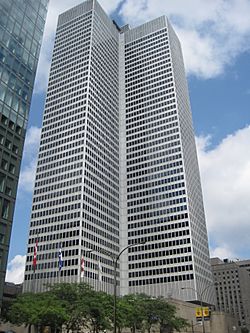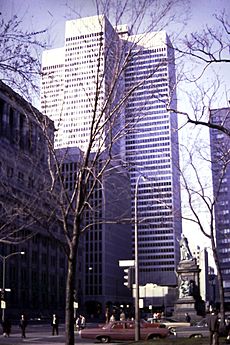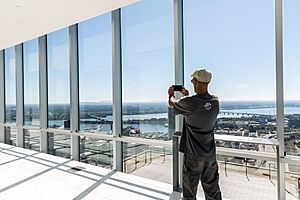Place Ville Marie facts for kids
Quick facts for kids Place Ville Marie |
|
|---|---|
 |
|
| Former names | Royal Bank Tower |
| General information | |
| Type | Office |
| Architectural style | International |
| Address | 1 Place Ville Marie Montreal, Quebec H3B 2B6 |
| Coordinates | 45°30′05″N 73°34′06″W / 45.5015°N 73.5684°W |
| Construction started | 1958 |
| Completed | 1962 |
| Owner | Ivanhoé Cambridge |
| Management | Ivanhoé Cambridge |
| Height | |
| Roof | 188 m (617 ft) |
| Technical details | |
| Floor count | 47 |
| Floor area | 95,922 m2 (1,032,500 sq ft) |
| Lifts/elevators | 32 |
| Design and construction | |
| Architect | I.M. Pei & Partners Dimitri Dimakopoulos |
| Developer | William Zeckendorf |
| Structural engineer | Severud Associates |
Place Ville Marie (often called PVM) is a big group of office buildings and shops in downtown Montreal, Quebec, Canada. It has four office buildings and a large underground shopping area. The main building, 1 Place Ville Marie, was built in 1962. It used to be called the Royal Bank Tower because the Royal Bank of Canada had its main offices there, and still does today.
This main building is 188 meters (about 617 feet) tall and has 47 floors. It's shaped like a cross. The whole complex is a key part of Montreal's Underground City. This is a huge network of tunnels that connects over 1,600 businesses, many subway stations, and a train terminal. You can walk indoors through these tunnels all over downtown Montreal! At night, a special light on top of the main building spins around. It sends out four bright white beams that can be seen up to 50 kilometers (about 31 miles) away. This light is just for show, not for airplanes.
Contents
What is Place Ville Marie?
When people say "Place Ville Marie," they often mean just the tall, cross-shaped building. But the name actually includes four smaller office buildings built around it in 1963 and 1964. It also includes the open plaza (a public square) on top of the biggest part of the shopping area, located between the buildings. Each building has its own address, like "1 Place Ville Marie" for the main tower, and "2, Place Ville Marie" for the others.
Over the years, the buildings and the plaza have been updated many times. In the most recent update, much of the old concrete in the plaza was covered with grass, flowers, and bushes, making it much greener. The entire complex has a huge amount of space, about 338,400 square meters (3.6 million square feet), and parking for around 900 cars. Many companies have offices here, with about 70 different businesses and 3,000 employees. For example, Via Rail, Canada's passenger train service, has its main office in "3, Place Ville Marie."
Building on a Unique Spot
The area where Place Ville Marie stands was once a big railway trench. This trench was dug into the side of Mount Royal for train tracks, connecting the Mount Royal Tunnel to Central Station. Because of this, most of the building was constructed right over these train tracks. This meant the building had to be extra strong to handle vibrations from the trains. As a result, it is the most earthquake-resistant office tower in Montreal!
Most of the land around the building belonged to the Canadian National Railway (CNR). The only exception was the old St. James Club. The developer, William Zeckendorf, even offered the club the top floor of the Place Ville Marie tower if they would sell their land, but they said no.
A Look Back in Time
Place Ville Marie was one of the first big projects designed by Henry N. Cobb, a famous architect. When it was first planned, some people didn't like it. They worried about how such a huge building would change downtown Montreal and how close it was to other important landmarks.
A design expert named Mark Pimlott noted that nearly half of the building's huge area is actually underground. This was a smart idea because it protects people from Montreal's very cold winters and hot summers. The complex has a large network of indoor spaces that feel like a continuous city, with grand public areas.
When it was finished, the main tower was the tallest skyscraper in the Commonwealth (a group of countries that were once part of the British Empire). It was also the third tallest skyscraper in the world outside of the United States. A few extra floors were added during construction to make sure it would be taller than the nearby Tour CIBC, which was being built at the same time.
Place Ville Marie was built when Montreal was the most important city in Canada. The biggest company to move in was the Royal Bank of Canada, which is the country's largest bank. They moved their main office from Old Montreal. Another large company, Aluminum Company of Canada (ALCAN), moved into six floors of the building in 1962. The central plaza became a very important public space. For example, a big election rally for Pierre Elliott Trudeau, who later became Prime Minister, was held there during the 1968 federal election.
The mayor at the time, Jean Drapeau, chose the name "Place Ville Marie" himself. "Ville-Marie" was the name of the original Catholic settlement founded in what is now Montreal in 1642.
Its Lasting Impact
On March 12, 1976, Canada Post released a special stamp featuring 'Place Ville Marie and Notre-Dame Church'. This shows how important and recognized the building had become.
Other Interesting Facts
The very top floor of the main building used to have a famous restaurant and nightclub called Altitude 737. It was named for its height above sea level in feet. This club was known for its unique dance floor that twisted and turned. Later, this space became the 360 Observatory, which offered amazing views of the city. However, it closed permanently in May 2020.
During the holiday season, a very large artificial Christmas tree is set up in the central court. The plaza also has a big fountain with water jets that can be programmed to create different patterns. In the center of the plaza, there's a large abstract sculpture called "Feminine Landscape" by Gerald Gladstone.
The complex is currently owned by Ivanhoé Cambridge, a company that bought the building in March 2000 for CA$450 million. You might have even seen the building in the film Scanners II: The New Order!
Images for kids
See also
 In Spanish: Place Ville-Marie para niños
In Spanish: Place Ville-Marie para niños





